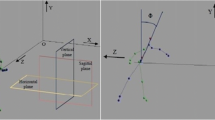Abstract
Hidden Markov Model (HMM)-based recognition methods are very commonly used for some applications and can be highly accurate. However, they have a high computational complexity that creates problems when they are used for gesture recognition on resource-constrained wearable devices. In this paper, we propose a pre-classification method to reduce recognition complexity by dividing gesture vocabularies into groups, and maintain, even improve, the recognition accuracy by adaptively adjusting the HMMs for different groups. The technique consists of three tasks: gesture grouping, group modeling, and gesture modeling. Gesture grouping is performed using a K-means++ algorithm; the groups are modeled using a table-based method; and the gestures are modeled using an HMM-based approach. We evaluated the pre-classification method using real data collected by a tiny finger-worn device called a Magic Ring. The complexity of our method is much less than the standard Hidden Markov Model, without any loss of accuracy.









Similar content being viewed by others
Explore related subjects
Discover the latest articles, news and stories from top researchers in related subjects.References
Junker H, Amft O, Lukowicz P, Troster G (2008) Gesture spotting with body-worn inertial sensors to detect user activities. Pattern Recognit 41(6):2010–2024
Zhou Y, Cheng Z, Hasegawa T et al (2012) Detection of daily activities and analysis of abnormal behaviors based on a finger-worn device. In: Proceedings of the 5th IET international conference on ubi-media computing, Xining, China
Li Y, Chen X, Tian J et al (2010) Automatic recognition of sign language subwords based on portable accelerometer and EMG sensors. In: Proceedings of the 12th international conference on multimodal interfaces, Beijing, China, pp 8–12
Kela J, Korpipää P, Mäntyjärvi J et al (2006) Accelerometer-based gesture control for a design environment. Pers Ubiquitous Comput 10(5):285–299
Rabiner LR (1989) A tutorial on hidden Markov models and selected applications in speech recognition. In: Proceedings of the IEEE, vol 77
Moni MA, Ali ABMS (2009) HMM based hand gesture recognition: a review on techniques and approaches. In: Proceedings of 2nd IEEE international conference on computer science and information technology, Beijing, China, 8–11 August 2009, pp 433–437
Mitra S, Acharya T (2007) Gesture recognition: a survey. IEEE Trans Syst Man Cybern, Part C, Appl Rev 37(3):311–323
Uddin MZ, Lee JJ, Kim T-S (2010) Independent shape component-based human activity recognition via hidden Markov model. Appl Intell 33(2):193–206
Maurer U, Rowe A, Smailagic A, Siewiorek D (2006) eWatch: a wearable sensor and notification platform. In: Proceedings of the IEEE international workshop on wearable and implantable body sensor networks, Cambridge, MA, USA, 3–5 April 2006, pp 142–145
Morganti E, Angelini L, Adami A et al (2012) A smart watch with embedded sensors to recognize objects, grasps and forearm gestures. In: Proceedings of international symposium on robotics and intelligent sensors, Kuching, Malaysia, pp 1169–1175
Kela J, Korpipää P, Mäntyjärvi J et al (2006) Accelerometer-based gesture control for a design environment. Pers Ubiquitous Comput 10(5):285–299
Junker H, Amft O, Lukowicz P, Troster G (2007) Gesture spotting with body-worn inertial sensors to detect user activities. Pattern Recognit 41(6):2010–2024
Amma C, Georgi M, Schultz T (2012) Airwriting: hands-free mobile text input by spotting and continuous recognition of 3d-space handwriting with inertial sensors. In: Proceedings the 16th of international symposium on wearable computers, pp 52–59
Kallio S, Kela J, Korpipaa P, Mantyjarvi J (2006) User independent gesture interaction for small handheld devices. Int J Pattern Recognit Artif Intell 20(4):505–524
Amstutz R, Amft O, French B et al (2009) Performance analysis of an HMM-based gesture recognition using a wristwatch device. In: Proceedings of the 7th IEEE international conference on computational science and engineering, Vancouver, British Columbia, 29–31 August 2009, pp 303–309
Jing L, Zhou Y, Cheng Z, Huang T (2012) Magic ring: a finger-worn device for multiple appliances control using static finger gestures. Sensors 12(5):5775–5790
Zhou Y, Jing L, Wang J, Cheng Z (2012) Separator design of gesture signals based on adaptive threshold using wearable sensors. In: Proceedings of the 26th international conference on advanced information networking and applications workshops, Fukuoka, Japan
Arthur D, Vassilvitskii S (2007) K-means++: the advantages of careful seeding. In: Proceedings of the eighteenth annual ACM-SIAM symposium on discrete algorithms (SODA’07), New Orleans, LO, 7–9 January 2007, pp 1027–1035
Fahim M, Fatima I, Lee S, Park YT (2013) EFM: evolutionary fuzzy model for dynamic activities recognition using a smartphone accelerometer. Appl Intell 39(3):475–488
Rekimoto J (2001) GestureWrist and GesturePad: unobtrusive wearable interaction devices. In: Proceedings the fifth international symposium on wearable computers, Zurich, Switzerland, 7–9 October 2001, pp 21–27
Kim IC, Chien SI (2001) Analysis of 3D hand trajectory gestures using stroke-based composite hidden Markov models. Appl Intell 15(2):131–143
Juang BH, Rabiner LR (1991) Hidden Markov models for speech recognition. Technometrics 33(3):251–272
Author information
Authors and Affiliations
Corresponding author
Rights and permissions
About this article
Cite this article
Zhou, Y., Cheng, Z., Jing, L. et al. Pre-classification based hidden Markov model for quick and accurate gesture recognition using a finger-worn device. Appl Intell 40, 613–622 (2014). https://doi.org/10.1007/s10489-013-0492-y
Published:
Issue Date:
DOI: https://doi.org/10.1007/s10489-013-0492-y




